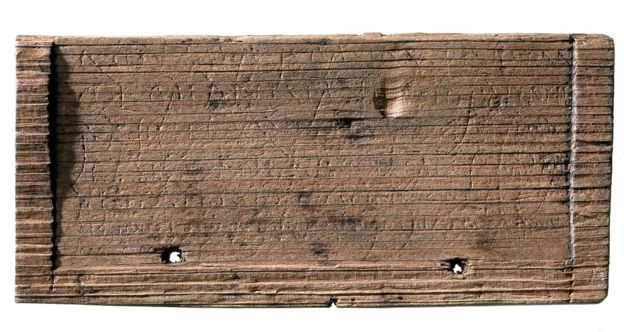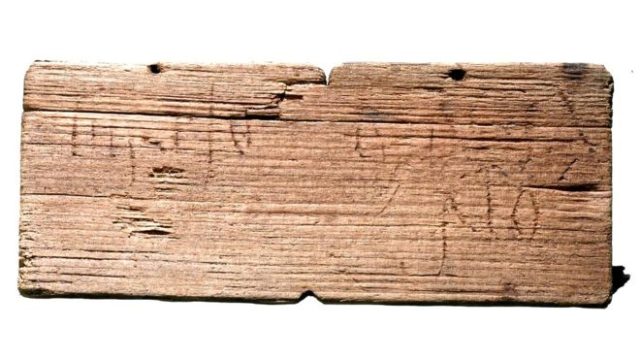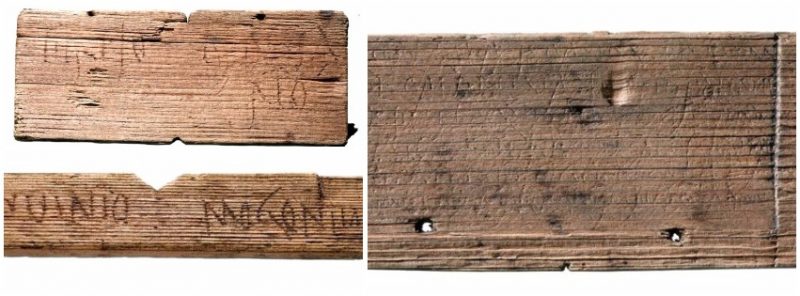An incredible discovery was made beneath a pub in London during work on the new European headquarters of the financial news company Bloomberg, located near the Bank Tube station.
Workers unearthed hundreds of wooden tablets that archaeologists believe were once used by Romans for writing notes, lists, brochures, and even IOUs. These tablets have been buried under twenty feet of mud for nearly 2,000 years, most of them date between 55 AD and 85 AD. The tablets were preserved by the mud on the banks of the River Wallbrook, where they were dumped.
Sophie Jackson, archaeologist and director at Museum of London Archaeology, explained, “The mud of the river was like the lava at Pompeii, preserving the best collection of wax tablets ever found in Britain.”

These tablets are not only the earliest handwritten documents ever found in Britain, but they also contain the first known reference to the city of London. After the archaeologists had deciphered the writing, they found that these tablets were used for virtually everything. They contained lists of names, events, business and legal dealings, and even someone practicing their alphabet and numbers.
The wooden plates were reconstituted from barrels or wine casks imported from the Continent. The writer would cover the wood with beeswax, using a heated spatula, and then carve the message with a stylus. Once the recipient received the letter, they could reheat the wax and send their reply back, usually via a slave.

Although the wax is no longer present, some of the writers carved their messages so deeply that the wooden mount was scratched, and the messages can still be read. Naturally, this means not all the tablets are readable, but archeologists are busy translating the ones they can.
The Bloomberg site didn’t just hold tablets; archaeologists found over 200 styluses that were used to write on the tablets, 300 brooches and dozens of different shoes, including a soldier’s hob-nailed boot and a lacy, perforated carbatina (essentially the Christian Louboutin of the day). A bread oven was also found, complete with the North African cockroaches that fed off piles of grain.
All of the items found provide valuable snapshots into the daily life of Romans in London. These suggest that within just a few years of establishment, London was already a whirring mix of commerce, eating, socializing, and fashion.
The earliest readable tablet that was unearthed dates back to 43 AD, the first decade of Roman rule. It reads, “…because they are boasting through the whole market that you have lent them money. Therefore, I ask you in your own interest not to appear shabby…you will not thus favor your own affairs…”
Another tablet appears to be a receipt for twenty truckloads of provision from St. Albans (Known as Verulanium). It is dated just two years after Boudica’s forces devastated swathes of Roman Britain.
Yet another note first appears to be just a shopping list, but after careful examination, historians believe that the note refers to a Roman proverb requesting the return of a favor. “…I ask you by bread and salt that you send as soon as possible the 26 denarii in victoriati and the 10 denarii of Paterio…”
As already mentioned, the tablets also contain the earliest known reference to London. Dated around 65 AD, it reads “Londinio Mogontio,” which translates to “In London, to Mogontius.” Of course, back in the day, people addressed letters differently than we do today. There were no house numbers, but rather just the names of the neighbors. For example, one address reads, “You will give this to Junius the cooper, opposite Catullus’s house.”
Researchers examining the tablets say that it appears that London back during Roman rule revolved around money, just as the modern-day London does.
Dated to the year 57 AD, one of the tablets references a consul; this is only nine years after London (Londinium) was founded by invading Romans. The note specifically states that it was written on the sixth day before the ides of January, January 8th, and reads, “I, Tibullus, the freedman of Venustus, have written and say that I owe Gratus, the freedman of Spurius, 105 denarii.” Another letter, written around AD43-53 shows Roman London was swarming with loan sharks, “They are boasting through the whole market that you have lent them money.”
Other finds include a soldier’s will from 67 AD, writing exercises from the first London school, and a record of a debt to Cripus, a brewer, for supplying nearly 3,000 pints of beer.

One of the researchers to translate the tablets was Dr. Roger Tomlin, a Roman historian, and the fellow of Wolfson College in Oxford. He said, “The Bloomberg writing tablets are very important for the early history of Roman Britain and London. I am so lucky to be the first to read them again, after more than 19 centuries, and to imagine what these people were like, who founded the new city of London.”
According to Dr. Tomlin, life was tough. Diseases were rife, and hygiene was poor for the majority. Infanticide was legal as child under two was the property of its father and could be disposed of as the father saw fit.
Yet, the image of the bloody Roman Empire occupying Britain isn’t entirely factual. The Empire was mostly a peaceful and prosperous place. These tablets are proof of that. The rate of literacy in a population is a sign of affluence. Rich men and women were in frequent correspondence.
“What a privilege to eavesdrop on them: when I decipher their handwriting, I think of my own heroes, the wartime academics who worked at Bletchley Park.” Dr. Tomlin said.
Although the writers of the tablets were mostly wealthy, they still provide insight to life in London. Translators have recorded some 129 people who are mentioned in the letters, including Roman emperors and aristocrats, slaves and a soldier who had fought for Emperor Augustus. Perhaps unsurprisingly, no women are mentioned. That being said, however, there are references to Roman and Celtic names, as well as soldiers from Gaul (France) and the Rhineland (Germany).
As previously mentioned, the earliest mention of London was found on the Bloomberg site. The name of the city is still a bit of a mystery to historians. Most researchers agree that the etymology of London is of Roman origin. One discarded theory of the origin suggests that it came from “King Lud.” Another thrown-out theory is that the city’s name is Celtic and means “place belonging to a man called Londinos.”
One theory that hasn’t been discarded is from Richard Coates in 1998. He suggested that London is from a pre-Celtic word for (p)lowonida that means “river too wide to ford.” This could refer to the River Thames and might a Welsh and Roman origin. One thing to note is that until 1889, the name London only applied to the City of London, but now applies to the county and Greater London.
During the time of Roman rule, there was an almost constant threat of revolt from the native Celtic peoples. With this in mind, it is not surprising that at the Bloomberg site, spears and fragments or armor were also found. Once all the artifacts have been uncovered, examined, and cleaned, the construction at the site will continue. Then, once the building is complete in the autumn, 700 of the artifacts will be displayed in the new Bloomberg headquarters.
Source: http://www.dailymail.co.uk/sciencetech/article-3620788/The-City-s-IOU-2-000-year-old-letters-reveal-daily-life-trade-debts-Roman-London.html
